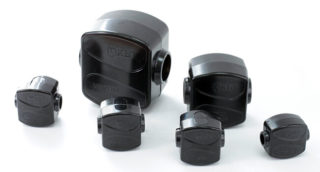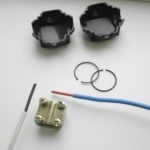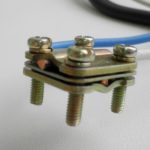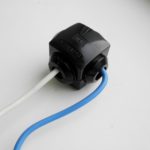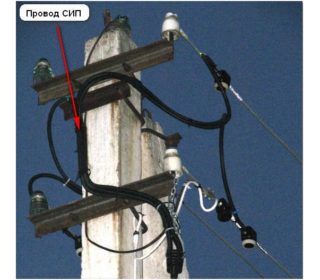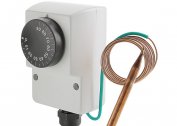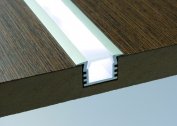For electrical work related to the arrangement of power lines or the formation of branches of the air cable from the main highway, it is supposed to use connecting adapters. An electric nut is one of the varieties of such connectors providing a high-quality transition contact and its reliable protection from external influences. To understand the principle of operation of the branching clamp under the name “nut”, you will need to familiarize yourself with its design and application features.
Design and installation features
The electrical connecting nut got its name because of the outward resemblance to a known fruit, which is directly related to the configuration of its hull.
In the official and working documentation, this type of intermediate connectors is called a branch clamp or, more simply, a clamp.
Outside, the nut for connecting the wires is protected by a durable and lightweight body made of polycarbonate and consisting of two halves. During assembly, these parts of the structure snap into place easily, forming a shape similar to a nut. Inside the structural element is a core consisting of 2 steel dies and a gasket plate. To obtain reliable contact, they are compressed together with the plate by means of special coupling bolts.
Purpose and advantages of connectors
The nut clamp for electrical wires is especially in demand in situations where it is necessary to prepare a branch from the main wire without the need for cutting it. A significant example of the use of this connector is the use in storey drive boards, from which electricity is supplied to apartments through branches from the main cable line. When making the next branch to the living room, the trunk wire at each site is laid in an inextricable way. Meals in individual apartments are served through the arrangement of branches with the use of "nuts" wiring.
In the event of a break in the main cable and the design of taps on the site using conventional contact pads, the reliability of power supply to individual consumers is sharply reduced.
With such an organization, the loss of contact on the second floor of the building, for example, will lead to the simultaneous disappearance of power in all apartments located in its upper floors.
It is allowed to install nuts for wires in power lines with an operating voltage of up to 660 Volts, within which it is possible to obtain a reliable connection of the outgoing wire to the main cable route. Thanks to the use of these electrical components, much less time is spent on the corresponding installation work. Moreover, the installer does not require special skills and efforts.
Nuts for connecting wires do not guarantee absolute tightness, since under certain conditions dust or moisture can get into them. To avoid this trouble, experts advise that after the formation of the connection, wrap the walnut compression housing with insulating tape.
Indisputable advantages of clamps of this type include:
- With their help, it is possible to connect the branches without breaking the cable.
- To work with these connecting elements does not require special training and high qualifications.
- Using nuts to connect electrical wires, it is possible to combine dissimilar materials (copper and aluminum, in particular).
The latter advantage is especially important when installing conductive lines, since in this case the oxidation of the contacts and the possibility of completely interrupting the supply of electricity to the consumer are excluded.
Application example and assembly order
As an example of the application of products of the “nut” type, a three-phase cable is usually considered, from which a 1.5 mm2 wiring is diverted. The correct approach to arranging such a branch involves the following procedure:
- On a cable line with a cross-section of 6 mm2 at the outlet, insulation is removed for the length of the pressure plate of the connector.
- Preparation of the nut itself is carried out, for which a screwdriver is taken and with its help it is first pried off and then the retaining ring on the case is removed.
- Halves of the product are disconnected.
- It is necessary to unscrew the clamping bolts from the contact plates.
- With the lead core with a smaller cross section, protective insulation is also removed for a length corresponding to the size of the pressure plate.
- 1
- 2
- 3
- 4
- 5
- 6
At the final stage of work, the exposed parts are first tucked into the grooves under the connector dies, and then tightened with screws with force.
Between the plates, it is mandatory to install a brass strip, which allows to obtain a large connection area and to exclude contact of dissimilar metals.
When tightening the screws, do not apply too much force that could damage the compression threads. Upon completion of this operation, they proceed to assembly of the walnut shell. It is important to distinguish between two halves in which there are four target holes. One of them is simply soldered, the other is intended for outputting the outgoing wire, and two more for wiring the main cable. Parts of the assembled housing are securely fixed with special retaining rings.
Combining tires from various materials
It is allowed to connect wires using electric nuts by more than one branch method. Due to the simplicity of the design and the reliability of the resulting connection, these elements are used on any sections of the existing electrical networks, including junction boxes. When using them inside the installation products, it is necessary to take into account the dimensions of the compresses themselves and select the boxes of the corresponding dimensions.
If it is necessary to connect aluminum and copper conductors, clamps for wires "nuts" are simply irreplaceable. The need for them is due to the following reasons:
- With direct contact of aluminum and copper wires, the metals in the connection zone oxidize over time.
- With prolonged use of the twist, it gradually breaks down and can weaken so much that the circuit along which the load current flows finally breaks.
- As a result of this destruction, the power supply to the object connected to it completely stops.
When forming nut-type joints, copper and aluminum wires are first freed from insulation to the width of the plate. After that, the fasteners are first loosened, and the corresponding wires are inserted into the freed grooves. At the final stage of assembly, they are tightened by previously loosened screws. Due to the fact that a brass plate is placed between the copper and aluminum wires in the nut, direct contact between them is not formed.
Branch from a pole of a high-voltage line
According to the provisions of the current regulatory documentation, work on connecting the cable stretched from the power transmission pole to the house entry is carried out by specialized organizations. This is because the open part of the general electricity supply route is very important from the point of view of the correctness of its arrangement.
Such work can be performed only by specialists who use special methods of laying lines during installation, including the design of branches from a typical SIP cable.
According to the requirements of the PUE, with the air supply method, the following types of wire material are allowed:
- Copper conductors with a cross section of 4 mm square with a distance from the pillar to the house of about 10 meters;
- the same cable, but with copper conductors with a cross section of 6 mm square - at distances of 10 to 15 meters;
- aluminum wires with a cross section of at least 16 mm in diameter - in all cases when in order to save their copper substitute is not used.
Arrangement of an outlet from a pole located on the street near the house is just the case when a through nut connection is required. When using this unifying element, it will be possible to ensure reliable contact between the conductors of the aluminum cable of the high-voltage line and the copper branch towards the residential building.
Walnut clamps for 220V wires are very popular among specialists in laying high-voltage lines. They are used wherever there is enough space for their placement, and guarantee a reliable connection of wires without their direct contact.
